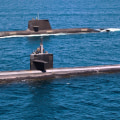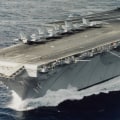China's two previous aircraft carriers, named after Shandong and Liaoning provinces in northeastern China, are considered less sophisticated than most of the United States, but they also represented milestones for the Chinese military, which for decades had focused on land warfare. The Chinese fleet already has nuclear-powered submarines. But submarine jets are poor candidates for transfer to a surface ship as large as an aircraft carrier. France learned that lesson a quarter of a century ago, Zhou said.
With the increasing attention paid to greenhouse gas emissions from the burning of fossil fuels for international air and maritime transport, in particular dirty fuel for the latter, and the excellent safety record of nuclear-powered ships, it is quite conceivable that a renewed interest in marine nuclear propulsion is likely to be seen. Global merchant shipping is reported to have a total energy capacity of 410 GWt, approximately one third of that of global nuclear power plants. Leaked CSSC details claim that China's fourth aircraft carrier will “displace between ninety thousand and one hundred thousand tons and will have EMALS catapults to get planes off deck. Fourth-generation Borei-class SSBN with a single 195 MWt OK-650 power plant is the first Russian design to use pump-jet propulsion.
A new Russian test bench submarine runs on diesel, but has a very small nuclear reactor for auxiliary power. The dismantling of dismantled nuclear submarines has become an important task for the navies of the United States and Russia. CGN then signed an agreement with the National Marine Petroleum Corporation of China (CNOOC) apparently to provide energy for offshore oil and gas exploration and production, and to “boost the organic integration of the offshore oil industry and the nuclear power industry,” according to CNOOC. Nuclear ships are currently the responsibility of their own countries, but none participate in international trade.
They conclude that the concept is feasible, but greater maturity of nuclear technology and the development and harmonization of the regulatory framework would be necessary before the concept became viable. Cugle) operated as a floating nuclear power plant (FNPP), designation MH-1A, moored in Gatun Lake, Panama Canal area. China has about 12 nuclear-powered submarines (about 8 SSN type 93 Shang class and class 95 Tang, approximately 6 SSBNs type 94 class Jin and type 9 class), and was building 21 more. For use in shallow waters such as estuaries and rivers, two 18,260 deadweight Taymyr-class shallow draft icebreakers were built in Finland with a 171 MWt KLT-40M reactor supplying 35 MW of propulsion and then equipped with its nuclear steam supply system in Russia.
There are credible anecdotal reports that dismantled Russian nuclear submarines have been used to provide electricity to remote communities and oil exploration companies in the Siberian Arctic regions, probably in the 1980s. Shipping company X-Press Feeders has invested in UK-based Core Power, which promotes modular molten salt reactors for marine propulsion. The power of the reactor ranges from 10 MWt (in a prototype) to 200 MWt in the largest submarines and 300 MWt in surface ships, such as Kirov class battlecruisers. Russia's main submarine power plant is the VM-5 PWR with a 190 MWt OK-650 steam generating unit, which uses 20-45% enriched fuel.
The LK-60 is powered by two RITM-200 reactors of 175 MWt each, which together deliver 60 MW in the three propellers through twin turbine generators and three electric motors. Nautilus led to the parallel development of other submarines (Skate-class), powered by individual pressurized water jets, and an aircraft carrier, the USS Enterprise, powered by eight Westinghouse jet units in 1960. The use of nuclear power on ships has been around since 1960 when USS Nautilus was launched as the world's first nuclear powered submarine. Since then there have been many advances in this technology which have enabled countries like China to develop their own nuclear powered vessels.
China currently has twelve nuclear powered submarines as well as two aircraft carriers which are considered less sophisticated than those from other countries such as the United States. The increasing attention paid to greenhouse gas emissions from burning fossil fuels has led to renewed interest in marine nuclear propulsion as it offers an excellent safety record with no emissions. This has led to companies such as X-Press Feeders investing in Core Power which promotes modular molten salt reactors for marine propulsion. The dismantling of dismantled nuclear submarines has become an important task for navies around the world due to their potential use for providing electricity to remote communities or oil exploration companies.
Russia has also developed a test bench submarine which runs on diesel but has a very small nuclear reactor for auxiliary power while China has signed an agreement with CNOOC to provide energy for offshore oil and gas exploration and production using their own nuclear power industry. The concept of using nuclear powered ships is feasible but requires greater maturity of nuclear technology as well as development and harmonization of regulatory frameworks before it can become viable on an international level. It is clear that there is potential for this technology to be used more widely but further research needs to be done before it can be implemented safely.



